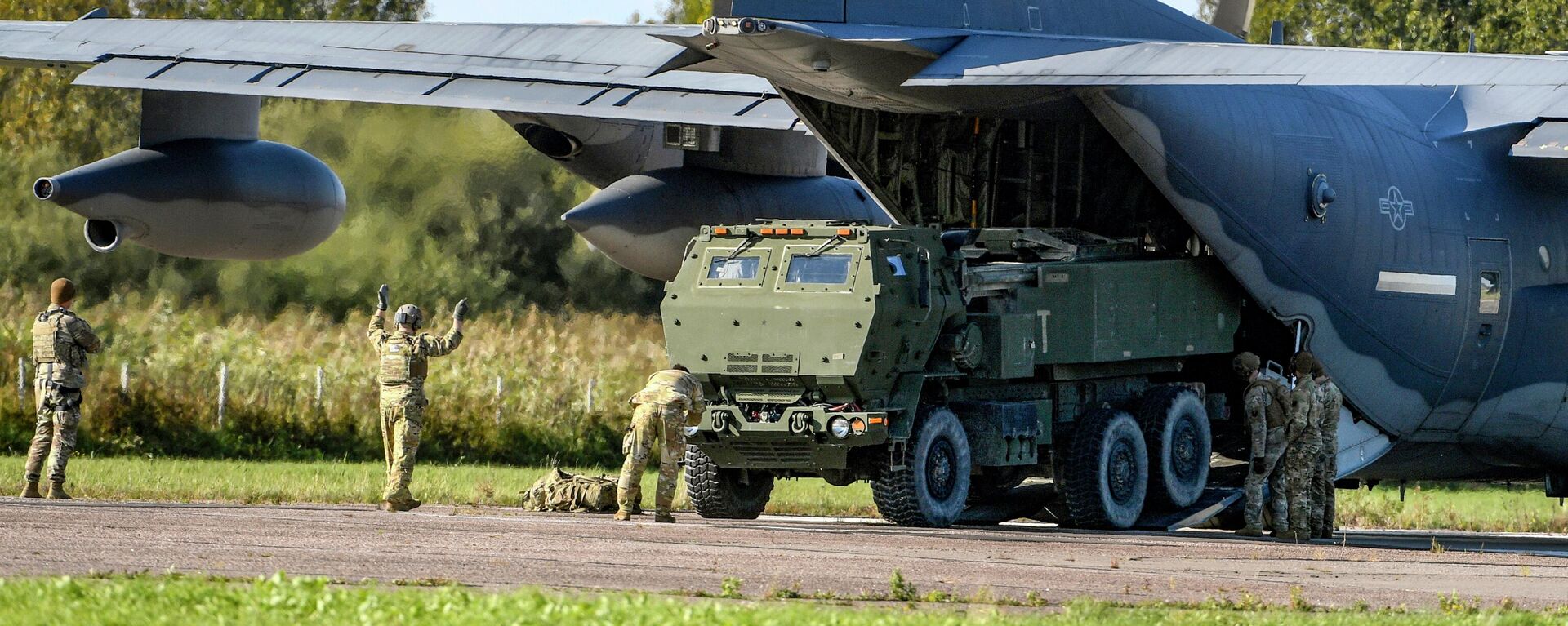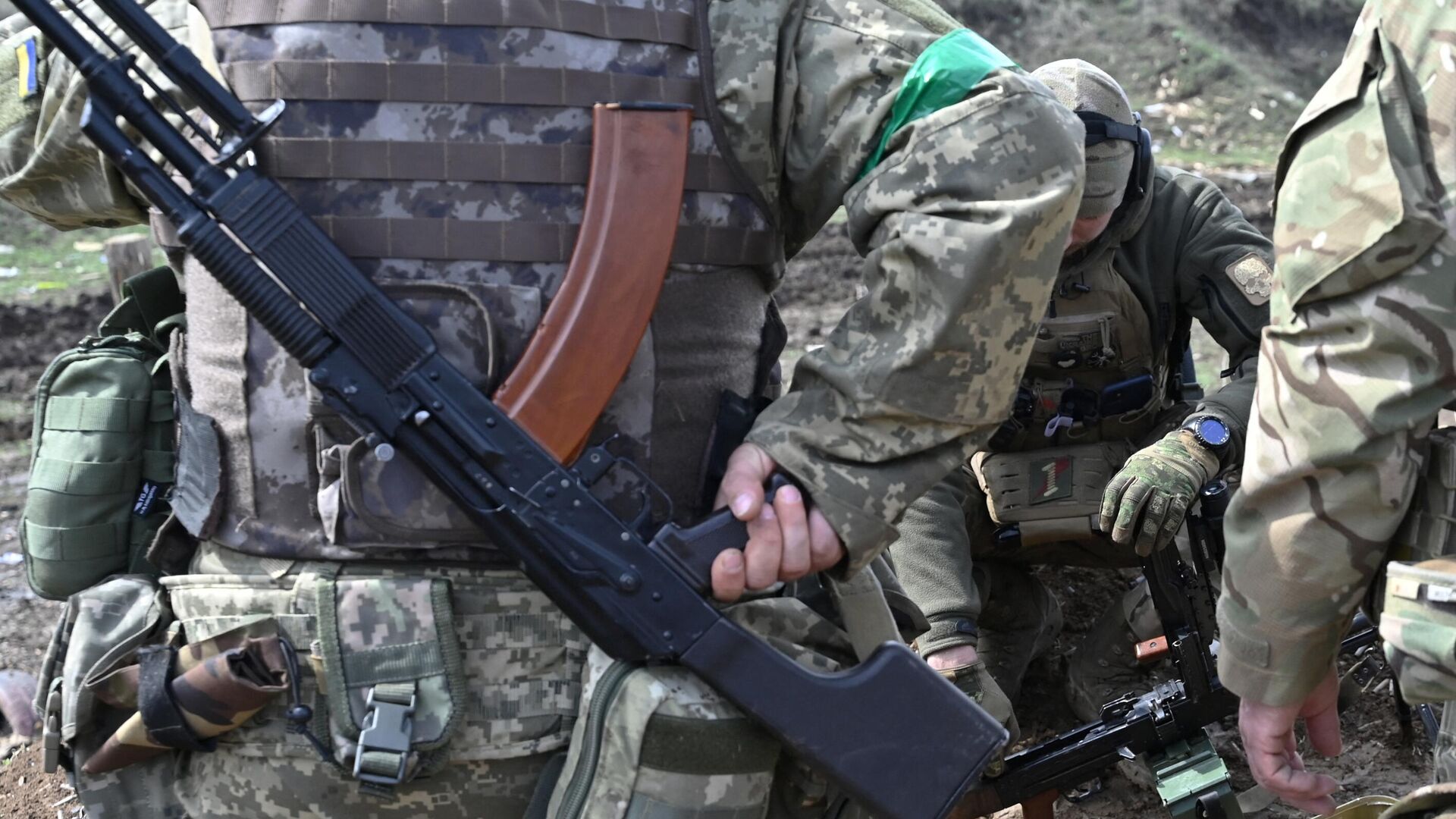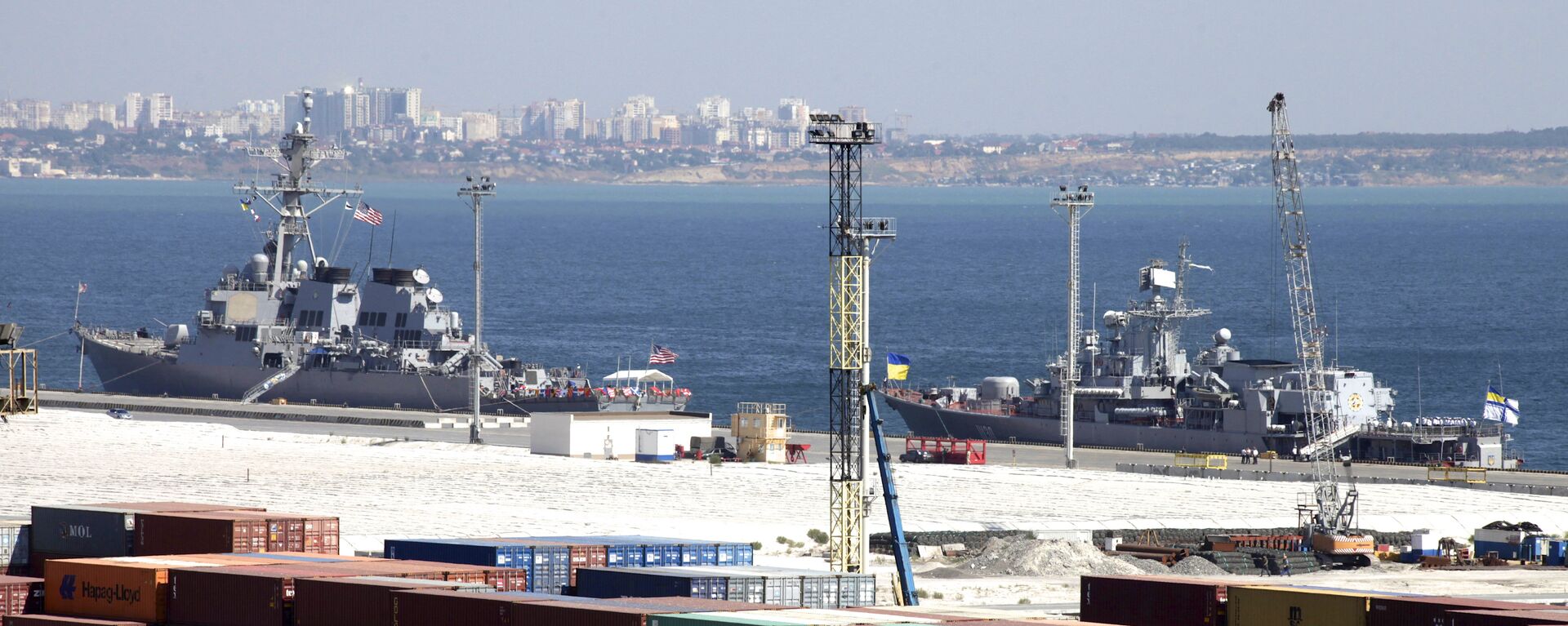https://sputnikglobe.com/20230515/scott-ritter-ukraines-counteroffensive---myth-or-reality-1110370203.html
Scott Ritter: Ukraine’s ‘Counteroffensive’ - Myth or Reality?
Scott Ritter: Ukraine’s ‘Counteroffensive’ - Myth or Reality?
Sputnik International
As we approach mid-May, the question on everyone’s mind is “where is the big Ukrainian counteroffensive”?
2023-05-15T09:01+0000
2023-05-15T09:01+0000
2023-05-15T18:58+0000
russia's special operation in ukraine
nato
high mobility artillery rocket system (himars)
ukraine contact group
jens stoltenberg
joe biden
volodymyr zelensky
ukraine
russia
lancet
https://cdn1.img.sputnikglobe.com/img/07e7/04/1e/1109984062_0:226:2835:1821_1920x0_80_0_0_0db7007948dd20b80bcd0a7889935440.jpg
This much-touted event has been percolating in the western mainstream media and social media channels since the Fall of 2022, when the commanding general of the Ukrainian armed forces, Valeri Zaluzhnyi, informed the US and NATO-led Ukraine Contact Group during a meeting in Ramstein, Germany, about the shopping list of military equipment Ukraine would need to carry out a successful offensive operation designed to expel Russian troops from Ukrainian soil. Since that time, the collective West has been working overtime to provide much of this material support, along with the training necessary for Ukrainian troops to employ it using standard NATO combined arms offensive operational and tactical doctrine.Jens Stoltenberg, the NATO Secretary General, announced in late April 2023 that NATO had delivered more than 98% of the equipment promised to Ukraine last fall, including more than 1,550 armored vehicles, 230 tanks, and “vast” amounts of ammunition—including, controversially, depleted uranium ammunition used in the British Challenger 2 main battle tanks, and the British-supplied “Storm Shadow” air-launched cruise missile. NATO, Stoltenberg said, also provided training for over 30,000 troops, enabling Ukraine to form nine fresh brigades of combat forces capable of delivering punishing blows against the Russian army in Ukraine.Not so fast. According to Ukrainian President Volodymyr Zelensky, while the Ukrainian army has enough trained troops to carry out a counteroffensive against Russia, some of the equipment these troops need has not yet arrived in Ukraine. Ukraine, Zelensky said, needs more time to carry out any major offensive operations. The Ukrainian President is currently on a tour of Europe, where he is pressing his NATO allies for even more military aid. The United States, Germany, and France have all promised to increase the amount of military assistance to Ukraine. The question that remains is when will Ukraine believe it has sufficient forces for the conduct of a successful offensive operation? The answer is more than likely “never.”The standard being used to measure the success or failure of any Ukrainian attack is unrealistically high—the September 2022 Kharkov offensive. Here, Ukraine was able to exploit Russian defensive positions that were inadequately manned, insufficiently prepared, and lacked any meaningful depth. Opting to trade land for lives, the Russian military conduced a withdrawal, allowing Ukraine to win a major propaganda victory while ceding little military advantage. Ukraine conducted a similarly successful operation against the right bank of Kherson, where once again Russia withdrew some 30,000 troops to avoid high casualties that would be accrued if they opted to defend largely indefensible territory.The nine Ukrainian brigades that NATO has helped train and equip are, if anything, more capable than the NATO-trained forces Ukraine used in Kharkov and Kherson. But so, too, are the Russian forces facing off against them. After the success of the Kharkov and Kherson operations, Russia conducted a partial mobilization of some 300,000 troops which, along with a parallel mobilization of volunteers, increased the number of forces available to the Russian command to around 700,000 troops. These troops have, for the most part, completed their training, and have either already been committed to the front lines or are being held in reserve for future military operations. The Russian defensive positions have been prepared in accordance with Russian doctrine, both in terms of density on the line of contact, the provision of sufficient fire support, and the preparation of second and third lines of defense to thwart any potential Ukrainian breakthrough. In short, if Ukraine does attack, it will be running into a steel barrier that is far different than what they confronted back in the fall of 2022.Moreover, Russia has further adapted to the realities of the modern battlefield. Ukraine’s use of US-provided artillery systems, including the HIMARS artillery rockets, has largely been negated by improved Russian operational art, designed to reduced potential targets for HIMARS, and new tactical actions, such as the employment of electronic warfare capabilities designed to jam the GPS signals used to guide HIMARS to its target, and improved air defense capabilities that end up shooting down the majority of the HIMARS rockets launched by Ukraine.Russia has likewise improved its use of “Kamikaze” drones—in particular the “Lancet” system—to hunt down and destroy critical Ukrainian military hardware and command and control capabilities. Russia has likewise incorporated new technologies of its own, including the employment of precision-guided “glide bombs” that have been used with devastating effect against Ukrainian troop concentrations. The Russian air force and navy have likewise been very effective in carrying out punishing attacks on Ukrainian arms and logistics depots in the Ukrainian rear using long-range drones and precision-guided missiles, destroying the very accumulations of ammunition and fuel Ukraine would need to carry out any meaningful and sustained military attacks. When added to the ongoing shortages Ukraine has regarding artillery shells and air defense systems, it is difficult to see how Ukraine would be able to conduct any successful attack against the Russian forces as things presently stand.The Ukrainian conflict has taken the US and NATO by surprise in terms of its intensity and lethality, both of which, at the end of the day, equate to the cost of waging modern war in terms of economic, material, and lives. While the cost of war is a two-way street, meaning that Russia is likewise suffering a massive human and economic toll, the ultimate question is what is the collective West’s pain threshold? While US Secretary of Defense Lloyd Austin noted a year ago that the goal of the US in Ukraine was to inflict pain on Russia of such intensity that it would serve to deter any future acts of Russian “aggression” in Europe, it is now becoming clear that it is the US which is beginning to feel the pinch, both in terms of the impact the continuing support for Ukraine has had on US military preparedness, and the high cost of underwriting Ukraine’s ability to sustain this war, which is currently estimated at more than $130 billion and growing.As President Joe Biden begins his bid for re-election, the domestic political consequences of a “frozen” conflict in Ukraine which continues to sap US military and economic resources will become a political liability. While Volodymyr Zelensky seeks more time to get fully prepared for a counteroffensive, time is not on the side of Ukraine’s number one supporter. At the end of the day, Ukraine will be pressured by the US to carry out a decisive strike against Russia it simply cannot accomplish. The 30,000 troops Ukraine has carefully accumulated will be lost fighting a Russian military than is more than capable of handling whatever Ukraine sends its way. This does not mean that Ukraine will not achieve momentary tactical advantage over small portions of the battlefield, or that Russia won’t suffer losses. But at the end of the day Russia is far more prepared to handle the consequences of a Ukrainian counteroffensive than Ukraine and NATO are, if and when it finally occurs.
https://sputnikglobe.com/20230426/nato-could-send-troops-to-western-ukraine-if-kievs-spring-offensive-fails---heres-why-1109858694.html
https://sputnikglobe.com/20230224/new-2bln-ukraine-aid-package-includes-himars-ammo-switchblade-drones-pentagon-says-1107765980.html
ukraine
russia
Sputnik International
feedback@sputniknews.com
+74956456601
MIA „Rossiya Segodnya“
2023
Scott Ritter
https://cdn1.img.sputnikglobe.com/img/07e6/0c/17/1105733958_0:0:334:334_100x100_80_0_0_b457e4e9c850ef224b0cc79059bb38df.jpg
Scott Ritter
https://cdn1.img.sputnikglobe.com/img/07e6/0c/17/1105733958_0:0:334:334_100x100_80_0_0_b457e4e9c850ef224b0cc79059bb38df.jpg
News
en_EN
Sputnik International
feedback@sputniknews.com
+74956456601
MIA „Rossiya Segodnya“
Sputnik International
feedback@sputniknews.com
+74956456601
MIA „Rossiya Segodnya“
Scott Ritter
https://cdn1.img.sputnikglobe.com/img/07e6/0c/17/1105733958_0:0:334:334_100x100_80_0_0_b457e4e9c850ef224b0cc79059bb38df.jpg
ukraine’s ‘counteroffensive’, nato-led ukraine contact group, nato secretary general
ukraine’s ‘counteroffensive’, nato-led ukraine contact group, nato secretary general
Scott Ritter: Ukraine’s ‘Counteroffensive’ - Myth or Reality?
09:01 GMT 15.05.2023 (Updated: 18:58 GMT 15.05.2023) As we approach mid-May, the question on everyone’s mind is “where is the big Ukrainian counteroffensive”?
This much-touted event has been percolating in the western mainstream media and social media channels since the Fall of 2022, when the commanding general of the Ukrainian armed forces, Valeri Zaluzhnyi, informed the US and NATO-led Ukraine Contact Group during a meeting in Ramstein, Germany, about the shopping list of military equipment Ukraine would need to carry out a successful offensive operation designed to expel Russian troops from Ukrainian soil. Since that time, the collective West has been working overtime to provide much of this material support, along with the training necessary for Ukrainian troops to employ it using standard NATO combined arms offensive operational and tactical doctrine.
Jens Stoltenberg, the NATO Secretary General, announced in late April 2023 that NATO had delivered more than 98% of the equipment promised to Ukraine last fall, including more than 1,550 armored vehicles, 230 tanks, and “vast” amounts of ammunition—including, controversially, depleted uranium ammunition used in the
British Challenger 2 main battle tanks, and the British-supplied “Storm Shadow” air-launched cruise missile. NATO, Stoltenberg said, also provided training for over 30,000 troops, enabling Ukraine to form nine fresh brigades of combat forces capable of delivering punishing blows against the Russian army in Ukraine.
Not so fast. According to Ukrainian President Volodymyr Zelensky, while the Ukrainian army has enough trained troops to carry out a counteroffensive against Russia, some of the equipment these troops need has not yet arrived in Ukraine. Ukraine, Zelensky said, needs more time to carry out any major offensive operations. The Ukrainian President is currently on a tour of Europe, where he is pressing his NATO allies for even more military aid. The United States, Germany, and France have all promised to increase the amount of military assistance to Ukraine. The question that remains is when will Ukraine believe it has sufficient forces for the conduct of a successful offensive operation? The answer is more than likely “never.”
The standard being used to measure the success or failure of any Ukrainian attack is unrealistically high—the September 2022 Kharkov offensive. Here, Ukraine was able to exploit Russian defensive positions that were inadequately manned, insufficiently prepared, and lacked any meaningful depth. Opting to trade land for lives, the
Russian military conduced a withdrawal, allowing Ukraine to win a major propaganda victory while ceding little military advantage. Ukraine conducted a similarly successful operation against the right bank of Kherson, where once again Russia withdrew some 30,000 troops to avoid high casualties that would be accrued if they opted to defend largely indefensible territory.
The nine Ukrainian brigades that
NATO has helped train and equip are, if anything, more capable than the NATO-trained forces Ukraine used in Kharkov and Kherson. But so, too, are the Russian forces facing off against them. After the success of the Kharkov and Kherson operations, Russia conducted a partial mobilization of some 300,000 troops which, along with a parallel mobilization of volunteers, increased the number of forces available to the Russian command to around 700,000 troops. These troops have, for the most part, completed their training, and have either already been committed to the front lines or are being held in reserve for future military operations. The Russian defensive positions have been prepared in accordance with Russian doctrine, both in terms of density on the line of contact, the provision of sufficient fire support, and the preparation of second and third lines of defense to thwart any potential Ukrainian breakthrough. In short, if Ukraine does attack, it will be running into a steel barrier that is far different than what they confronted back in the fall of 2022.
Moreover, Russia has further adapted to the realities of the modern battlefield. Ukraine’s use of US-provided artillery systems, including the
HIMARS artillery rockets, has largely been negated by improved Russian operational art, designed to reduced potential targets for HIMARS, and new tactical actions, such as the employment of electronic warfare capabilities designed to jam the GPS signals used to guide HIMARS to its target, and improved air defense capabilities that end up shooting down the majority of the HIMARS rockets launched by Ukraine.

24 February 2023, 10:40 GMT
Russia has likewise improved its use of “Kamikaze” drones—in particular the “Lancet” system—to hunt down and destroy critical Ukrainian military hardware and command and control capabilities. Russia has likewise incorporated new technologies of its own, including the employment of precision-guided “glide bombs” that have been used with devastating effect against Ukrainian troop concentrations. The Russian air force and navy have likewise been very effective in carrying out punishing attacks on Ukrainian arms and logistics depots in the Ukrainian rear using long-range drones and precision-guided missiles, destroying the very accumulations of ammunition and fuel Ukraine would need to carry out any meaningful and sustained military attacks. When added to the ongoing shortages Ukraine has regarding artillery shells and air defense systems, it is difficult to see how Ukraine would be able to conduct any successful attack against the Russian forces as things presently stand.
The Ukrainian conflict has taken the
US and NATO by surprise in terms of its intensity and lethality, both of which, at the end of the day, equate to the cost of waging modern war in terms of economic, material, and lives. While the cost of war is a two-way street, meaning that Russia is likewise suffering a massive human and economic toll, the ultimate question is what is the collective West’s pain threshold? While US Secretary of Defense Lloyd Austin noted a year ago that the goal of the US in Ukraine was to inflict pain on Russia of such intensity that it would serve to deter any future acts of Russian “aggression” in Europe, it is now becoming clear that it is the US which is beginning to feel the pinch, both in terms of the impact the continuing support for Ukraine has had on US military preparedness, and the high cost of underwriting Ukraine’s ability to sustain this war, which is currently estimated at more than $130 billion and growing.
As President Joe Biden begins his bid for re-election, the domestic political consequences of a “frozen” conflict in Ukraine which continues to sap US military and economic resources will become a political liability. While Volodymyr Zelensky seeks more time to get fully prepared for a counteroffensive, time is not on the side of Ukraine’s number one supporter. At the end of the day, Ukraine will be pressured by the US to carry out a decisive strike against Russia it simply cannot accomplish. The 30,000 troops Ukraine has carefully accumulated will be lost fighting a Russian military than is more than capable of handling whatever Ukraine sends its way. This does not mean that Ukraine will not achieve momentary tactical advantage over small portions of the battlefield, or that Russia won’t suffer losses. But at the end of the day Russia is far more prepared to handle the consequences of a Ukrainian counteroffensive than Ukraine and NATO are, if and when it finally occurs.





